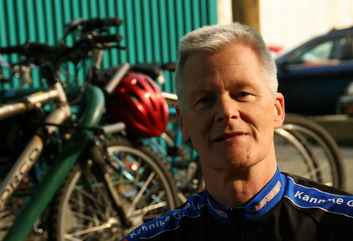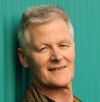

by Udo Erasmus

I fly a lot. Long flights that span more than 4 time zones used to be a big problem for me. Flying from Canada to Australia or to Europe, I’d find it impossible to stay awake in the afternoon and impossible to sleep during the night.
The reason: My melatonin cycle was adapted to North American west coast time, but my body was elsewhere. It always took 5 to 7 frustrating days for my sleep cycle to normalize.
Many people have asked me how I do it. So I decided to share it. It is really easy.
Melatonin makes us drowsy. Light blocks melatonin production during the day, and thereby keeps us awake. When it gets dark in the evening, melatonin production starts up again, and prepares us for sleep by making us drowsy again. This is, by the way, the main reason why the room we sleep in should be completely dark, and why it is much better for health to learn to trust the darkness than to keep a ‘night light’ on. Night-lights, coffee, and other stimulants interfere with melatonin production, making it more difficult to get a ‘good night’s sleep’.
 When we live normal lives, we spend our
days and nights in the same time zone. Our melatonin
production cycle is adjusted to this time zone’s
light and dark cycle. We wake up when it gets light,
and we get drowsy as the light fades. In such a stable
situation, the melatonin production cycle becomes
habitual.
When we live normal lives, we spend our
days and nights in the same time zone. Our melatonin
production cycle is adjusted to this time zone’s
light and dark cycle. We wake up when it gets light,
and we get drowsy as the light fades. In such a stable
situation, the melatonin production cycle becomes
habitual.
It is this habitual melatonin production that causes
jet lag when we move rapidly through many time zones.
Our body may be in Australia, but our melatonin production
cycle is still on North American time. To adjust to
the new time zone, this habitual melatonin production
cycle needs to be broken and re-set. Normally, this
takes up to a week, but with some help, the habitual
melatonin production cycle can be broken during the
time of our long flight, and re-set in the new time
zone.
At the speed of walking, it
would take us many days to move just one time zone,
and our melatonin cycle would have plenty of time to
adjust to the change of time zone. In the old days,
moving across America (3 time zones) would take months,
even years. But the unnatural speed of air travel,
rapid movement through many time zones—something
our bodies were not biologically built for—has
become routine for people doing international business,
for tourists, for vacationers, and for those traveling
to family reunions.
Fast, far, east-west and west-east travel creates
a situation in which the melatonin production cycle
remains adjusted to the time zone from which we came,
and requires several days to a week to adjust to
the new time zone. When we pass quickly through many
time zones, the melatonin cycle continues to respond
in its habitual mode, independent of whether it is
light or dark outside.
To break and re-set my melatonin
production cycle, I make use of two natural products.
The first is called a relaxation-inducing herbal sedative
called Neurapas (Pasco), which is made up of a mixture
of dry herbal extracts from St. John’s Wort,
valerian root, and passionflower. I take 3 tablets
three hours before my flight leaves, one tablet at
flight time, and one tablet every hour during the flight.
I stop taking Neurapas about one hour before I arrive.
 The second product I use on long flights is melatonin. I have used liquid as well as tablet forms and different doses of this sleep /
antioxidant / anti-cancer hormone. After much experimentation, I have settled
on using 1 milligram per hour, in tablet form. I take
one tablet as soon as we are airborne, then one tablet
every hour during the entire flight. I stop within
the hour before landing.
The second product I use on long flights is melatonin. I have used liquid as well as tablet forms and different doses of this sleep /
antioxidant / anti-cancer hormone. After much experimentation, I have settled
on using 1 milligram per hour, in tablet form. I take
one tablet as soon as we are airborne, then one tablet
every hour during the entire flight. I stop within
the hour before landing.
It is important to take the melatonin
at one-hour intervals during the entire flight.
Taking it every hour keeps melatonin in present in
your body, which signals to the pineal gland that the
body has enough, that no more is needed, and that production
therefore should cease, whether it is light or dark.
This shuts down melatonin production during the flight.
The pineal gland gets to rest throughout the flight.
On arrival, stop taking melatonin. If the flight
lands at night, your melatonin production will naturally
start up again, because it is now dark. You will
be able to sleep.
If the flight lands during the day,
melatonin production will continue to be inhibited
by the light. You then stay up until day ends and it
gets dark where you are, at which time melatonin production
will start up again. You may have been up for a long
day (as many extra hours as the number of time zones
you passed through), are likely to be quite tired,
and will sleep beautifully. Next morning, you’ll
be completely adjusted to the time zone.
That is the power of stopping and re-setting your
melatonin production cycle during your flight.
When a flight spans 4 time zones or less,
I do not use melatonin and herbal sedative,
because the sleep cycle is manageable. When a flight
is 5 time zones or more, I must use them to prevent
jet lag.
I do not use this system on north-south flights,
if 4 or fewer time zones are traversed. Going straight
north and south, the time zones do not change, so
the sleep cycle is not disrupted.
 Using this method, I have flown from Vancouver
to Europe (8 or 9 time zones, flying east), gone to bed at normal European bedtime,
and woken up ready to go the next morning, and experienced no jet lag at all.
Using this method, I have flown from Vancouver
to Europe (8 or 9 time zones, flying east), gone to bed at normal European bedtime,
and woken up ready to go the next morning, and experienced no jet lag at all.
I have flown from Europe to Vancouver (8 or 9 time zones, flying west), gone to bed at normal West Coast
bedtime, and woken up ready to go the next morning, with no jet lag at all.
I have flown west from Vancouver to Australia
(7 time zones) and east from Australia (or Tokyo, Singapore, Hong Kong)
using my method with no jet lag. I have flown west from Australia to Europe
(9 time zones) and east from Europe to Australia—no jet lag.
I have flown east from Europe to India (4 or 5 time zones)
and west from India to Europe and experienced no jet lag at all.
By taking melatonin at one-hour intervals during the flight, our pineal gland’s
melatonin production is stopped. Stopping melatonin
production by taking melatonin during the flight puts
the gland in a state of restful inactivity. This restful
inactivity, which lasts as many hours as the flight,
breaks the gland’s habitual melatonin production
cycle. Cessation of melatonin intake then allows for
the pineal to start up melatonin production again,
based on the light-dark cycle at the traveler’s
destination.
The habitual melatonin production cycle will have been
broken. A new melatonin production cycle, aligned with
the light-dark cycle of the destination, can then begin.
 I want to emphasize one more
time that it is important to take melatonin at regular,
one-hour (+ or –15 minutes) intervals, so that
melatonin production is stopped, the gland rests, and
it can then start up again in the new time zone. Whenever
people tell me that melatonin does not work for them,
and I enquire how they use it during flights, invariably
they are not following a regular schedule. When they
do it the way I suggest, then melatonin works also
for them.
I want to emphasize one more
time that it is important to take melatonin at regular,
one-hour (+ or –15 minutes) intervals, so that
melatonin production is stopped, the gland rests, and
it can then start up again in the new time zone. Whenever
people tell me that melatonin does not work for them,
and I enquire how they use it during flights, invariably
they are not following a regular schedule. When they
do it the way I suggest, then melatonin works also
for them.
The best dose of melatonin to take for
best results may vary slightly for different individuals.
Although I have not seen it, someone lighter or heavier
than I (180 pounds) may need less or more than I for
the best results. Be open to that possibility, to find
what is the best individual dose for you. It will not
be far from 1 milligram/hour for the entire flight.
I do not recommend taking melatonin every night. Chronic
use of supplemental melatonin can result in the gland
becoming lazy. It is better to get the gland to do its
job, except short-term, in situations that are not natural
to our biology, such as flying.
It is, however, useful to take melatonin on a daily
basis for older people whose pineal gland is not
producing enough. This is usually not an issue for
some people younger than 60 years old. Some older people may
be unable to sleep more than 4 hours a night, and then
be tired all day, because their pineal gland is no
longer producing enough melatonin for a good night’s
sleep. For these people, regular melatonin use may
be helpful. A health practitioner’s guidance
should be followed in these cases.
By the way, I do not sell either the herbal sedative or melatonin.

I’m passing on this information simply because
I have found it so useful in my own life.
References made to supplementation are anecdotal and should not
be construed as medical advice. Before changing your diet or
undertaking any supplementation, please consult a nutritionist,
naturopath, or nutritionally-trained physician.